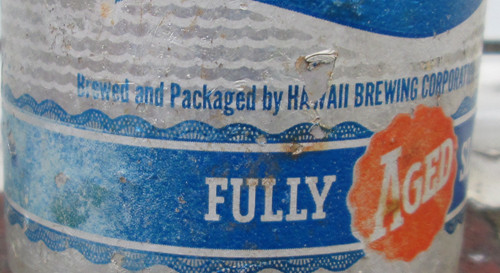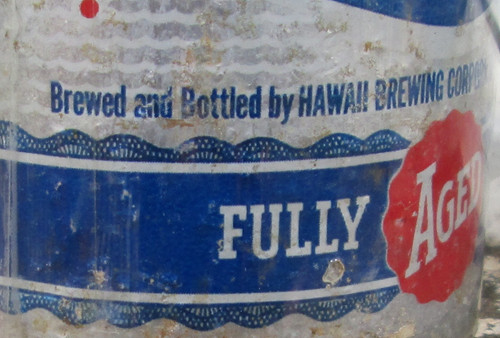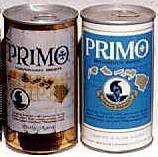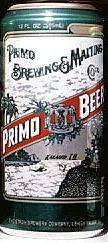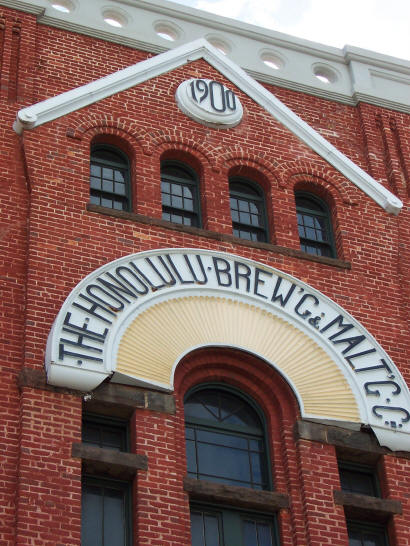Primo Beer: 1958-1959
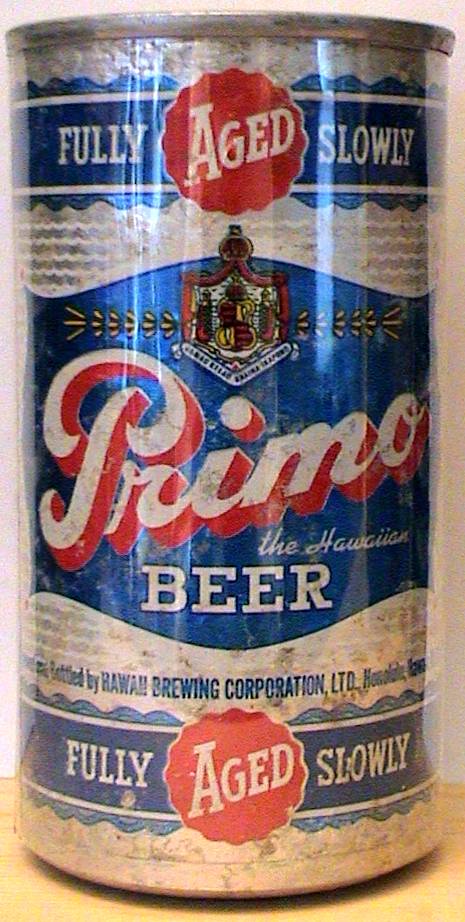 |
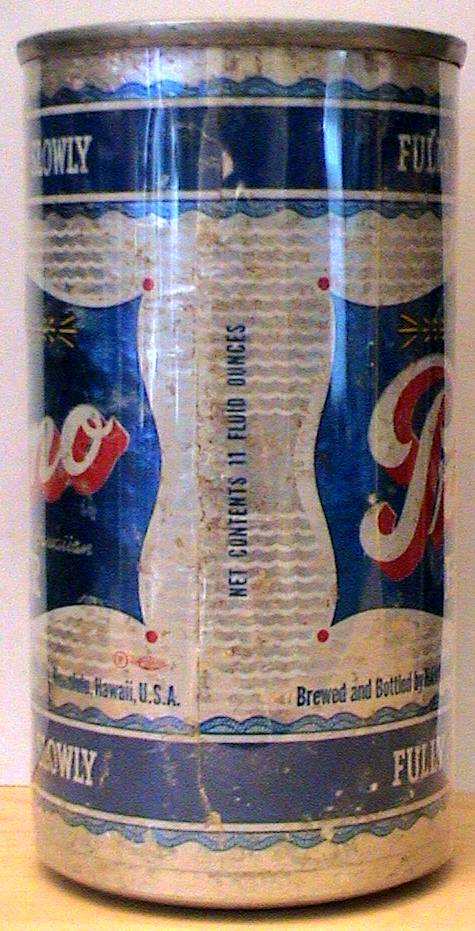 |
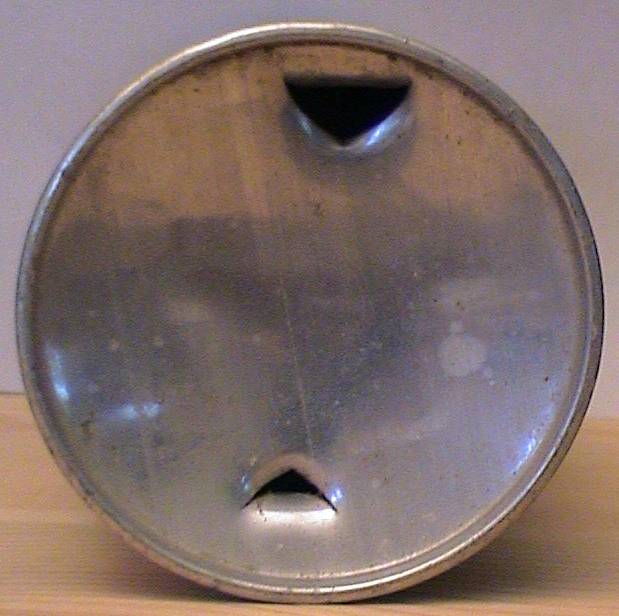 |
Primo Beer can with a foil wrap-around label. Plus a view of the unique concave top.This month's featured example is a can that I had wanted for years, ever since I went to Hawaii on a family vacation in 1976. It's a Primo Beer from Hawaii Brewing Company produced in 1958. Unfortunately for Hawaii Brewing, the can was poorly designed and it proved to be a disaster for the brewer. It's one of the first all aluminum beer cans, has a foil label and a soft concave aluminum top. It is also an 11 ounce can, as opposed to the normal 12 ounces most brewers made. I picked this example up at the 2004 Blue-Gray show in Fredericksburg, Virginia.
Hawaii Brewing: 1898-1963
Hawaii Brewing was started in 1898, the same year Hawaii was annexed by the United States, as the Honolulu Brewing Company. It was renamed the Honolulu Brewing and Malting Company in 1900 and remained in business until 1920, when Prohibition started in the Territory of Hawaii. In 1934 it began operation again as the Hawaii Brewing Company.
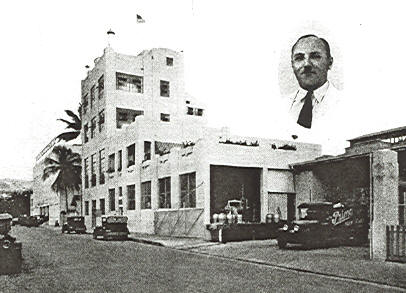
The Hawaii Brewing Company circa 1935 with Master Brewer John B. Dirnberger.
Hawaii was to become a state in 1959, and so to celebrate Primo in 1958 decided to issue its beer in a can for the first time. However, shipping material to Hawaii is expensive so the company searched for ways to reduce shipping weight. Instead of the steel cans every other brewer that canned used, Hawaii Brewing purchased equipment to make their own lightweight aluminum cans. They found that the metal necessary to make 24 aluminum cans weighed 2 pounds, while the tinplate normal beer cans weighed 5 pounds for 24 cans. In addition, by buying the cans as unfinished metal discs, Primo could ship many more cans in the same amount of space, thus cutting shipping costs even further. The brewery also planned to recycle their used cans, thus reducing shipping expenses even more.
The relevant technology had been developed in Germany, but several American companies had joined forces in 1954 to create Aluminum International. Formed by Coors Brewing, Los Angeles investor Louis Bronstein, and Beatrice Foods (which owned Primo at that time), Aluminum International created an automated and economical process to turn aluminum slugs into cans for food and beverages. A prototype was tested at Coors in Colorado.
The aluminum slugs were created in the US then shipped, along with the lids, to Hawaii. Primo planned on setting up the proper machinery in the future to make their own, but never had the chance. The process of turning a slug into a can took several steps...
- A piston driven by 400 tons of pressure struck a 3/16th inch aluminum disk in a die turning it into a lidless one piece 11 oz can. The can stamping machine could turn out 120 cans a minute.
- Next the cans were trimmed to eliminate the rough edges along the top.
- The cans were sent through a 36 foot long washer/drier to be cleaned.
- The cans' interior was sprayed with an alcohol-resistant lacquer lining.
- They were then baked for 8 minutes to seal the lacquer.
- The cans were then fed into an unscrambled on their way to the filler.
The cans went into production in July 1958. Primo planned on producing 60% of their beer in cans, and 40% in bottles using 60 tons of can slugs per month once the system was in full use. (No mention was made of draft beer) The sixty tons of slugs could be reduced as previously used cans were recycled. The brewery was even developing a new form of can opener to remove the entire can lid, leaving a smooth edge so that the can could be used as a glass. They even bought new packing machines that would handle the aluminum cans. When the cans went on the market (apparently over the beer-friendly July 4th weekend in 1958) it appeared as if Primo was about to pull off a real packaging coup.
Unfortunately for the brewer, and the consumer, the cans were not appropriately designed for holding beer. The special lining did not adequately protect the beer from the metal, resulting in 23,000 cases of spoiled beer. Also, the concave top actually dipped into the beer so when the can was opened the beer would spray out. Moreover, an overly enthusiastic (or overly thirsty) customer could accidentally punch their church key not only through the lid, but with the soft aluminum top and body, could actually keep going and punch the opener through the can's side at the same time. The cans ended up being recalled and dumped, but the damage was done to the brewery's reputation. In late 2005 I received an email from a Marine who was stationed in Hawaii in 1959. He tried the beer in these cans and was not impressed (to put it mildly) . He described the cans as "cardboard " and noted that his fellow Marines preferred buying other brands of beer to accepting Primo for free! Now THAT'S a bad reputation! Hawaii Brewing Company ended up declaring bankruptcy.
UPDATE: 2019: The brewery did not give up however, and continued trying to market their beer in the cans. into at least late 1961. Newspaper articles and advertising also indicate that the brewery continued trying to market their beer in cans through late 1961, rather than discontinuing them in 1959 as originally assumed.
There are two variations of the 1958-1961 paper-label Primo I did not know about in 2004. On one the mandatory reads “packaged” and the other reads “Brewed and Bottled.” I do not know if one is more difficult to find than the other, but I did have to look awhile before finding one that said "Packaged."
Schlitz Takes Over.
The Schlitz brewing Company took over in 1963 and quickly turned the business around. Brewing of Primo Beer expanded and the brewery went to 24 hour a day operations. In 1966 a new, more modern, brewing facility opened in Pearl City. By the beginning of the 1970s, Primo Beer market share peaked with 70% of the local market. In part this was due to local loyalty since this was "Hawaii's beer", but the tourist trade also helped as the many visitors to the islands wanted to try the local brew. Schlitz started canning Primo Beer again in the early 1970s and came out with several cans that were very popular with the collectors of the time. Canning beer in Hawaii was still expensive, so in 1979 Schlitz moved the canning operation to the mainland. Unfortunately, moving the canning operations only weakened the local support in Hawaii for "their" beer.
Primo cans from the 1970s. From One Beer Lover to Another: Strohs.
In 1983 Strohs Brewing in Detroit purchased Schlitz, including Primo. Strohs brewed Primo in Longview, Texas and they tried to arrest Primo's declining sales, which had dropped from 12,000 cases a month to 1,200. Primo was sold in parts of California and on Cape Cod, Massachusetts. Attempts were made to sell it Oklahoma, Texas and Colorado. It was even sold for a time in Japan. Strohs also changed Primo's label, copying a 1904 label.Strohs efforts made some progress, in 1986, they increased back to 12,000 cases a month, but they soon began declining again. Surprisingly, market analysts attributed some of the rise and fall to the color of the bottle used. When Strohs sold Primo in a green bottle, sale rose. When they sold it in a brown bottle, sales fell. Brown bottles are actually better for the beer inside because brown glass protects the beer from light better than green, and light hurts a beer's freshness. However, consumers liked beer in green bottles. Beers such as Heineken are sold in green bottles and consumers saw green as a symbol of quality as opposed to brown.
Stroh's efforts to promote Primo failed and the last batch was brewed in November 1997 and was sold in May 1998, almost exactly 100 years since it was first brewed in Hawaii.
A 1980s Primo can copying the early 20th Century label.
More Info Wanted:
Do you have information about Alfred Hocking or the early history of this brewery? If so, then Bruce Hill, one of Alfred's descendents, would like to hear from you (as would I!). Please email Bruce. He can share information and photos.
The old Honolulu Brewing Company brewery today, photo by Dr. L. Bruce Hill.
Sources Used:
Beer Can Collectors of America. United States Beer Cans. (Beer Can Collectors of America: Fenton, Mo)
"Beer in Aluminum Cans" Modern Metals (August 1958)
"Develops Automatic Production of Aluminum Cans." Brewers Digest. (May 1957)
"First Aluminum Canned Beer." Modern Packaging. (September 1958)
"Hawaii Brewing Corp Using Aluminum Cans." Brewers Journal. (September 1958)
"Major Breakthrough for Aluminum Beverage Cans" Food Engineering (September 1958)
Photo of brewery. Brewers Digest. (April 1935)
"Primo...Pride of the Islands." Brewers Digest. (February 1957).
"Primo Scores a "First'." Brewer's Digest. (August 1958)
"Special Aluminum Can Packer for Six-Packs Developed by Andre Paper Box Company." Modern Brewery Age. (November 1958)
Web sites
"Primed to be the Next Primo" by Alex Salkever. Hawaii Business.
"Primo is Pau." by Andrew Gomes. May 1, 1998. Pacific Business News.
"Craft Beer Industry benefits more than just the thirsty" July 9, 2000. Hawaii Island Economic Development Board.

